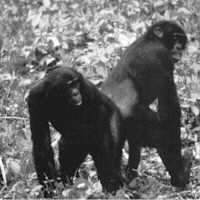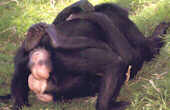 |

 |
|
By Jack Nichols
 A social revolution is at hand involving homosexual, bisexual and transgendered behaviors. A major zoological study Biological Exuberance: Animal Homosexuality and Natural Diversity by Bruce Bagemihl (St. Martin's Press, 1999) has destroyed old and laughable zoological interpretations and has put same-sex love and affection onto a trajectory that leads to a revised way of seeing the world. A social revolution is at hand involving homosexual, bisexual and transgendered behaviors. A major zoological study Biological Exuberance: Animal Homosexuality and Natural Diversity by Bruce Bagemihl (St. Martin's Press, 1999) has destroyed old and laughable zoological interpretations and has put same-sex love and affection onto a trajectory that leads to a revised way of seeing the world.
Bagemihl's book provides "an affirmation of life's vitality and infinite possibilities: a worldview that is at once primordial and futuristic, in which gender is kaleidoscopic, sexualities are multiple and the categories of male and female are fluid and transmutable." Such a multi-sexual worldview is no longer theoretical. Bagemihl says the material he's gathered about animals' varied same-sex mating habits points to exactly the same world that's inhabited by we humans.
Why? The orthodox cast those who refuse their "proper" sex-cult rules into a pit of contentions. But both the ideological fanatics and ordinary humans may perish because of the authoritarian group's unwillingness—even to the point of sanctioning deadly violence-- to admit to or to permit variety and elasticity in it's midst. Because the anti-homosexual taboo discourages "too much" natural bonding among men, a heavily confrontational culture usually develops to ward off unfettered affection with macho-boastful, theatrical enthusiasms like those that are appreciated by WFW fans. A well-known heterosexual Buddhist scholar and author, the late Alan Watts, puts it this way:
With the publishing of Bagemihl's Biological Exuberance, the age-old charges, most often touted by "religious" cults, quickly become frontline Religious Reich ideological casualties, namely that same-sex love is "unseemly', 'unnatural' or 'against nature'. His book, a major revolutionary study published in our times, serves front line lesbian, gay, bisexual and transgender activists, providing a stunning and fascinating investigation into the variant love lives of creatures great and small. It deserves the rapt attention, some believe, that is given to other great revolutionary works published over the centuries. Bagemihl triumphantly investigates herds and hosts of living beings—including insects, reptiles, birds and mammals, until, one feels tempted to say, as a legendary Quaker gentleman once did in a different context: "All the world's a little queer but me and thee. And sometimes I wonder about thee." Four-hundred and fifty species are examined in Biological Exuberance, proving that heterosexual behaviors in animals are simply part of a much more expressive continuum, just as Alfred Kinsey had written to be so about humans. It is significant that the Religious Reich has sought to destroy Kinsey's reputation because they know his findings give the lie to their "religious" dogmas. If mean-spirited fundamentalist attempts to ruin Kinsey's personal reputation had actually been successful, and even if his famed 1940/50's studies Sexual Behavior in the Human Male and Sexual Behavior in the Human Female had been unfairly discredited and expunged by these same religious fanatics, the truths these books contained would still have been resurrected in other forms. Thus, the publication of Biological Exuberance points publicly today to a similar sexual diversity in animals that Kinsey, Pomeroy and Martin first discovered in their studies of humans. What are some of the questions that Biological Exuberance posits? Do animals same-sex kiss with passion? Yes, the walrus does, certainly, as do African elephants and mountain zebras (males). Among the most homosexually-joyous animals, ones whose makeup is closer to human beings is a highly intelligent ape known as the Bonobo. Bonobo society, in contrast to that which afflicts scrappier chimp cousins, is both passionate and peaceful.
Highly significant, says Ms. McCarthy, is how Bagemihl "ridicules the ingenious explanations researchers have given for why animals might appear not to be straight arrows." "They're showing dominance," is one oft- used excuse, or "it's appeasement," or "they're just confused." Ms. McCarthy points out that "some homosexual animals have one night stands and some have long marriages. Gay and lesbian geese stay together year after year." Bottlenose dolphins, she explains on behalf of Bagemihl, shy away from heterosexual pairing, but males can many times be inseparable mates. Previously, pure gay animalism had been best covered over 30 years ago in Wainwright Churchill's pioneering work Homosexual Behavior Among Homosexual Males: A Cross-Cultural and Cross-Species Investigation (Prentice-Hall, 1967). Churchill's study, which covered males only, was a comprehensive look at same-sex love-making as a fact of life rather than as a sin, crime, or disease. Today Biological Exuberance has an added advantage in that it studies the females of our varied species. Like Churchill's book, Bagemihl's much-expanded work of today is grounded in scientific principles and argues effectively for a humanistic approach to sex, accepting that there's no single pattern of sex that can be universalized for all people (or animals.) Wainwright Churchill quotes Kinsey in a way that now highlights Bagemihl's new, more comprehensive research. Alfred Kinsey says: "It is unwarranted to believe that particular types of sexual behavior are always expressions of psychoses or neuroses. In actuality they are more often expressions of what is biologically basic in mammalian and anthropoid behavior." Jack Nichols, GayToday's Senior Editor is the author of The Gay Agenda: Talking Back to the Fundamentalists (Prometheus, Books) Available: www.amazon.com |



